Flossing 101: Why It’s Essential & How to Do It Right
Brushing your teeth is an essential part of maintaining good oral health, but if you’re skipping flossing, you’re missing a key step in keeping your teeth and gums healthy. Flossing removes plaque, food particles, and bacteria from between your teeth—areas that your toothbrush can’t always reach. In this guide, we’ll break down why flossing is essential and how to do it properly.
Why Flossing Matters
Many people assume that brushing alone is enough to prevent cavities and gum disease. However, here’s why flossing is just as important:
✔ Prevents Cavities: Plaque buildup between teeth can lead to decay in hard-to-reach areas. Flossing removes plaque before it turns into cavities.
✔ Protects Against Gum Disease: Plaque that isn’t removed can cause inflammation, leading to gingivitis (early-stage gum disease) and, if left untreated, periodontitis (advanced gum disease).
✔ Keeps Your Breath Fresh: Flossing removes trapped food and bacteria that cause bad breath.
✔ Improves Overall Health: Studies show that gum disease is linked to conditions like heart disease and diabetes, making flossing beneficial for more than just your mouth.
How to Floss Properly
Flossing doesn’t take long, but doing it correctly ensures you get the best results. Follow these simple steps:
1. Choose the Right Floss
- Traditional floss: Available in waxed and unwaxed varieties. Waxed floss slides easily between tight teeth.
- Dental tape: Wider and flatter, ideal for those with more space between teeth.
- Floss picks: Convenient for on-the-go use but may not reach all angles as effectively.
- Water flossers: A great alternative for people with braces, sensitive gums, or difficulty using traditional floss.
2. Use the Right Technique
1️⃣
Cut about
18 inches of floss and wrap most of it around your middle fingers, leaving about two inches to work with.
2️⃣ Hold the floss taut between your thumbs and index fingers.
3️⃣ Gently slide the floss between your teeth using a back-and-forth motion. Avoid snapping it against your gums.
4️⃣ Curve the floss around the base of each tooth in a
C-shape and slide it slightly under the gumline.
5️⃣ Use a clean section of floss for each tooth.
6️⃣ Repeat the process for all teeth, including the back molars!
3. Floss Daily
The best time to floss is before brushing so that your toothbrush can remove loosened debris. Aim to floss at least once a day—your gums may bleed at first, but this is normal and should stop as they become healthier.
Flossing Tips & Tricks
✔
Floss at the same time every day to build a habit—before bed is a great option!
✔ Struggling with technique? Try using a water flosser or floss picks for convenience.
✔ If your gums bleed frequently when flossing, it could be a sign of gum disease. Schedule a dental checkup!
Final Thoughts
Flossing is a simple yet powerful way to protect your teeth and gums. At Mighty Molar, we’re here to help you maintain a healthy smile. If you have questions about your flossing routine or need a professional cleaning, book an appointment with us today!











